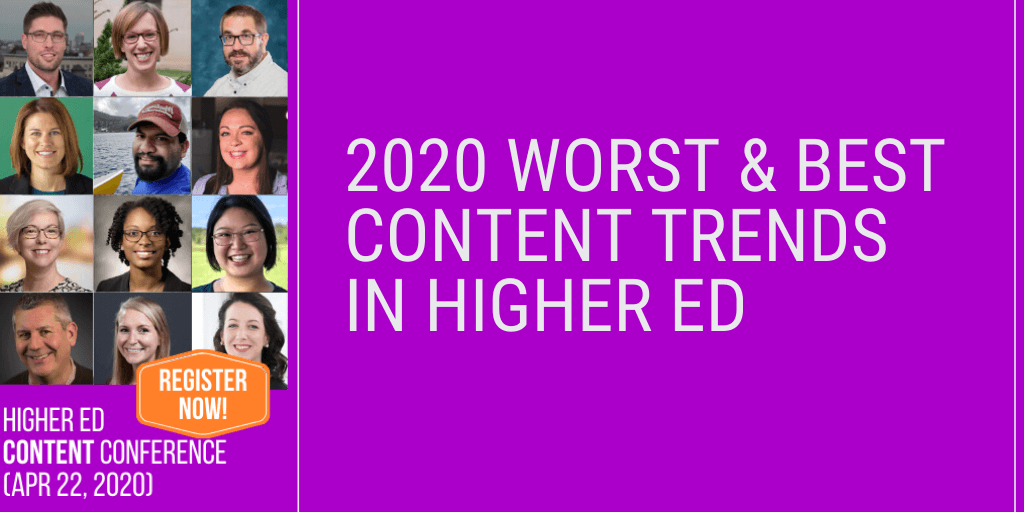In higher education, sharing is more than caring. It’s a way of life in our professional circles :-).
Whether we share our higher ed content work in conference presentations, articles, posts or on social media, this sharing culture tends to reinforce trends, good or bad, even more than in any other industries.
I believe It’s healthy to know our strengths and weaknesses as a profession.
So, I asked the speakers of the 2020 Higher Ed Content Conference (HECO20) to identify the best (and worst) trends in higher ed content.
While your higher ed colleagues made their own selection independently, some clear patterns emerged from this panel of 12.
The worst higher ed content trends in 2020?

What makes your higher ed colleagues cringe when they look at higher ed content?
The HECO20 panel identified the following trends that wouldn’t be missed if they were to go. Find out their reasons by scrolling down or following these quick links:
- Higher ed content that doesn’t fit in size or format
- Lazily designed higher ed content
- Social media accounts without any strategy
- Using YouTube as a repository for higher ed videos
- Facebook events without any content
Higher ed content that doesn’t fit in size or format
Allison Turcio, Director of Digital Strategy – Siena College

The worst trend is posting content that just does not make sense for that specific platform.
I will give you two examples: posting YouTube videos on Facebook and event flyers on Instagram. Content for social media should be native to each platform. Instead of posting the YouTube link (Facebook’s competitor!), upload the video directly to Facebook. And of course, there is nothing native about an 8.5″ x 11″ sheet of paper to any social media network!
Morgan Campbell, Social Media Specialist – Indiana University Bloomington

It’s time to kiss good-bye content that physically doesn’t fit your channel. Brands who are not formatting their graphics or videos to fit the screen are missing the mark. We have so much free real estate in these platforms that aren’t being used because we are using the same wide graphic across. If you want your followers to stop and notice something, you need to make sure they see it first. Think of it this way, if you grab your mail from your mailbox, you will notice the most significant piece of mail that fits inside. So, let’s start using our given space and take up our followers’ entire screen.
AJ Lopez III, Manager, Digital Marketing & Social Media – Midwestern State University

I was guilty of doing this in the past, but posting flyers that have not been formatted to social media.
It happens, especially when you have to make deadlines, and that’s understandable. The accounts that do this on a daily basis, and especially on Instagram which is a photo-centric social media are a problem. We need to make better content, and not just post another flyer.
Kait Lanthier, Content Strategy Director – Babson College

Flyers on social media, especially Instagram, are the worst. There are a host of issues associated with this tactic—accessibility and readability, to start—but at its core, the problem is with the practice itself. If your social media strategy is strictly one of event promotion, you’re missing the point of social media. What are users going to Instagram for? Not to see a digital replication of a bulletin board in the campus center. To make the content fit right social, you have to think beyond the transactional desire to fill seats and think about the strategy behind each platform. When we’re asked to think about event promotion as a tactic, we back up and ask, “What story are we trying to tell?” Once we have that conversation, a thoughtful strategy—with channel-appropriate tactics—follows suit.
Lazily designed higher ed content
Holly Hill, Director of Digital Strategy – Flagler College

Worst content trend: Creating content for the sake of flooding your channels. Anyone can create digital content, right?
There is a myth that if you own a computer, phone, or tablet and have a website or are active on social, you are automatically an expert.
How does this translate in Higher Ed? You get lots of requests to “just post content,” as is and make sure it’s everywhere. Let’s start reframing this conversation in 2020.
Jenna Spinelle, Communications Specialist – Penn State McCourtney Institute for Democracy

Stale, overly-processed quotes! You can spot them a mile away in news stories about everything from faculty research to student success.
If it sounds like it came from a robot, no one is going to take the story seriously. We all have real personalities in there somewhere; I would love to see more of these personalities come through this year.
Jeff Bunch, Web Content Strategist – Gonzaga University

One of the worst trends I’d like to kiss goodbye is the creation of content under the guise of storytelling which is created solely for marketing purposes.
If executed without a lot of strategic thought, it undermines the authenticity of all storytelling efforts as a legitimate vehicle for university marketing and advancement divisions.
Janice Cheng-McConnell, Admissions Communications Manager – Wells College

I think volume-based mass direct mail campaigns is a content trend in higher education that needs to go in 2020. Prospective students in particular are hyper-sensitive to relevant brand messaging, and they can spot a merge field from a mile away. This renders that direct mail piece with ambiguous “You’re in” content ineffective because your recipient most definitely knows that it’s one of 500,000 that was sent that week. We have more data about our audiences than ever before. We need to do better with personalizing content and sending information to people that’s actually relevant to their expressed interests and behaviors. Your audience is actively looking for value and meaningful ways to connect, and direct mail is a great way to do this without engaging in false pretenses. Make your value(s) easy to understand and which clear actions they should take in order to benefit from it. Treat your audience with the same kind of respect and trust you are asking from them.
Jason Miller, Digital Specialist – York University

Chatbots: I think most students are not satisfied with the technology. If done perfectly, they may be helpful, but more times than not, they just create more challenges and frustrations than they are worth. Given that a student using the chatbot may need specific questions regarding their personal information or have a more technical question, chatbots are often just a hurdle of customer service. Real support services can react and adapt to the complexity of issues. AI programs are only as useful as the information in their database. More often those making inquiries will skip the bot and go directly to the live support.
Social media accounts without any strategy
Molly Gluck, Digital Communications and Public Relations Associate – Boston University

One trend higher education needs to leave behind is creating unbranded, unpopulated social accounts for schools, departments, athletic teams, clubs, and other groups within an institution.
Social media is a powerful, dynamic way for colleges and universities to connect with students, faculty, and external audiences. However, launching and growing an engaging account requires time, effort and strategy. For example, you cannot post the same content and social copy across different social platforms and accounts; each channel has a different audience, and requires thoughtfully tailored content and tone to reach them. A higher education social media communicator must: 1) Clearly identify/brand the account and its content with the university, 2) Take the time to source and develop compelling visual content (i.e. videos, photos, GIFs, graphics, etc.), and 3) Post customized content on a daily basis. If these three core components cannot be met, individuals should aim to promote content over the institution’s main social media accounts when appropriate instead of launching an account on their own.
Using YouTube as a repository for higher ed videos
Morgan Glover, Associate Director, Social Media Strategies – UNC Greensboro

What has to go away for us: Using YouTube primarily as a repository for video embeds. Shifting the YouTube strategy at UNC Greensboro became a priority last year. We’ve made some progress, increasing views and subscribers as result. A few years ago, we joined other institutions in prioritizing direct video uploads for Facebook, Twitter, and LinkedIn. That’s still a good practice, but now we’re thinking about how to intentionally increase our subscribers on YouTube, because it’s such a popular channel with students.
Facebook events without any content
Andrew Cassel, Social Strategist and Content Producer – Middlebury College

Creating a Facebook Event for events without a strategy to update the Event after it’s created. All too often a Facebook Event is created for the next job fair, visiting speaker, or even a commencement ceremony and then left to sit empty and alone. Facebook Events can be powerful tools – if you share them regularly across platforms and create or curate content that you post to the Event. An Event with no content is like a party with no people. I don’t want to go to that party. And there’s no need for me to join that Event.
The best 2020 content trends in higher ed?

What makes your higher ed colleagues hopeful and happy when they look at higher ed content?
The HECO20 panel identified the following trends that they’d love to see spread more widely. Find out their reasons by scrolling down or following these quick links:
- User-generated and user-centered content
- More human, conversational and accessible content
- Story-based, multi-platform content
- Long-form videos
- Data-driven visual content
User-generated and user-centered content
Molly Gluck, Digital Communications and Public Relations Associate – Boston University

User-generated content should continue to be prioritized across higher education institutions. It is the perfect way to highlight the authenticity of your organization, and connect with your followers in a personal (and engaging) way. User-generated content enables higher-ed communicators to provide an inside-look into the daily lives of the student body – and feature the individuals, events, communities and achievements that make each institution unique, appealing and welcoming. Not only is user-generated content an effective way to connect with on-campus communities – but it also helps showcase what makes your school lively and special to prospective students, parents, and external audiences.
AJ Lopez III, Manager, Digital Marketing & Social Media – Midwestern State University

I do enjoy seeing more accounts use user-generated content and allowing students to do takeovers on accounts.
Students like to show off what they enjoy about their university. Universities enjoy giving a different perspective of college life from real students.
As long as universities keep authenticity in social media, they could use this in recruiting future students.
Andrew Cassel, Social Strategist and Content Producer – Middlebury College

Facebook Groups are an often-neglected but very powerful tool for building community around a department, school, student organization or meme group. Creating and administering a Group takes time and commitment. It is difficult to find that time with all the other things we’re doing. Set the simple goal of a number of people to join a group like Campus Events. Promote that Group with a paid strategy. Provide exclusive content for the Group. Prospective students will get a better idea about the cool things happening on your campus, current students will know more about the opportunities they have to attend an interesting lecture, alumni will see the kind of content they’re supporting with their money, and your campus communities will see how you benefit the local economy. You have to commit to the Group. You have to support the Group. You will come to love the Group.
Morgan Glover, Associate Director, Social Media Strategies – UNC Greensboro

I’d like to see a couple trends take off. One is simple: Universities using AR effects for Instagram stories, which are just plain fun and a great way to build affinity with current and future students, and young alumni. I’d also like to see colleges and universities creating more compelling and user-friendly content that positions their institutions as community resources. More news-you-can-use from faculty. Better calendars on websites. Admissions-driven marketing will always be important, but many people have an opportunity to interact with and build affinity with universities long before and after they earn a degree there.
More human, conversational and accessible content
Morgan Campbell, Social Media Specialist – Indiana University Bloomington

One thing I have loved seeing universities do more often is more authentic, positive, and conversational content. It’s content that makes your followers stop and engage with it, because they want to be part of the post too. A great example of this is when @IUPUI posted on Twitter:
“Ok, enough gloomy weather. Let’s make our own sunshine. Tag someone you met at IUPUI who has changed your life for the better & tell us how.”
Several followers starting commenting with positive messages, those who didn’t follow may now follow IUPUI because they were tagged, and it was also great content to monitor. As social media managers, our content is only as good as we are feeling. Finding ways to bring positive content into the lives of students can be hard some days, but the results can surprise you.
Allison Turcio, Director of Digital Strategy – Siena College

What I’m looking forward to in 2020 is more content with personality.
We’ve seen it happening with big name brands, which are becoming more human on social media.
Who doesn’t love Wendy’s sass on Twitter? The key is finding a unique voice that’s authentic to your institution.
Jason Miller, Digital Specialist – York University

Humanization with Brand Hosts: New platforms are regularly emerging and require different content strategies to hit their main demographic and content requirements. When comparing a brand’s content on Instagram to its TikTok, it can be hard to identify similarities. Brand hosts will create synergy and brand recognition cross-channel. These roles will continue to grow in popularity, beyond media outlets and into higher ed. These people will become the face of social media and provide a personal connection across the many social channels. These brand hosts will be key in showcasing student events, campus experiences, informal interviews and much more, and will humanize the channels by embodying the brand personalities.
Janice Cheng-McConnell, Admissions Communications Manager – Wells College

One of the best trends that I would love to see become more popular in 2020 is the “trend” of making accessible content a requirement, not a passing fad. Technology permeates every aspect of life in higher education and campuses are racing to catch up to their diverse audiences. Whether that’s captioning a video or making sure PDFs on the .edu becoming landing pages that are easy for screen readers, I would love to see accessibility become a new normal way of life in higher education.
Story-based, multi-platform content
Jeff Bunch, Web Content Strategist – Gonzaga University

One of the best content trends I’d like to see spread is using short-form multimedia content (video/social combined with traditional methods) across platforms.
The hybrid story (text, photos, video, user generated-content) which is both created and shared across multiple platforms is powerful.
It both gives voice to fans and amplifies yours.
Jenna Spinelle, Communications Specialist – Penn State McCourtney Institute for Democracy

I would love to see more multi-platform storytelling that incorporates written, audio, and video content. For example, a story in an alumni magazine that’s released with a companion podcast episode diving deeper into what makes that person interesting or a recruitment video that’s a compilation of Instagram stories with voiceovers from the students who took them.
Long-form videos
Kait Lanthier, Content Strategy Director – Babson College

I’d love to see a rise in the strategic use of long form video. I know, I know; for years we’ve been hearing, “attention spans are short!” and have been capping our videos at 30 seconds to one minute because of it. I get it. And in some cases, this is absolutely the best way to go. But I’d love to see content creators focus less on the logistics of “how long” and more on the quality of the story they are trying to tell. That means some videos will be snackable, others will be long form, but their length will be dictated by the content quality, not by the notion that everything has to fit into thirty seconds.
Data-driven visual content
Holly Hill, Director of Digital Strategy – Flagler College

My favorite content trend would have to be data-driven visual content. Pause for a moment and take the time to analyze your audience’s behavior and what part of the journey they are on- are they just seeking information, or are they ready to commit? Now here comes the fun part: create your content with gusto, because you have a little more information to be purposeful.
A conference focusing on higher ed content?
The Higher Ed Content Conference is a must-attend event for higher ed content professionals and teams looking for new ideas and best practices.
Read below what a few of your higher ed colleagues who attended the past editions of the Higher Ed Content Conference say about the experience.

